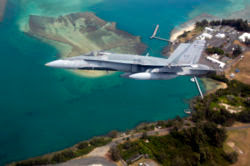CF-18 over Hawaii (Wikipedia)
A hat-tip to reader John, who discovered this item in the Halifax Nova Scotia Chronicle Herald. In a conversation with the paper’s editorial board last Friday, Lieutenant General Angus Watt, Chief of the Canadian Air Staff, revealed that CAF fighters also intercepted Russian Bear bombers over the Arctic last week. The Canadian intercept occurred as Russia dispatched 14 long-range bombers on missions over the Pacific, Atlantic and Arctic Oceans.
In other words, last week’s reported flight of eight Bear H’s over the North Atlantic was part of a much bigger effort–apparently, one of the largest (if not the largest) operation by Russian bombers since the Cold War. General Watt didn’t provide specifics on the Canadian intercept, but it apparently happened about the same time that Norwegian F-16s, and later, British F3 Tornadoes were shadowing TU-95s over the North Atlantic. According to General Watt, the Canadian encounter took place just outside his country’s airspace, near Inuvik in the Northwest Territories.
“It’s where we pay attention to people coming in,” Lt.-Gen. Watt said. “They were never in our airspace. They were never in our sovereign territory.”
But the Russian aircraft were within visual range of the Canuck fighter pilots during their meeting, something that has become a more frequent occurrence lately.
[snip]
“We have responded in the traditional way to Russian incursions of our airspace by meeting them as they enter our airspace with our fighters to escort them through to show them that we’re paying attention,” Lt.-Gen. Watt said.
Despite the apparent flexing of Russian military muscle, don’t expect a return to the icy animosity that once existed between the Kremlin and countries belonging to the North Atlantic Treaty Organization.
“It’s a different world. We’re not going back to the Cold War,” Lt.-Gen. Watt said.
General Watt did not specify the number of TU-95s intercepted by Canadian fighters. And so far, there’s been no reporting on the “Pacific leg” of the operation. For decades, Russian bombers have periodically tested U.S. air defenses in such locations as Alaska and Guam prompting scrambles by USAF F-15s and U.S. Navy aircraft. Russian Bear and TU-22M Backfire bombers have also flown profiles against Japan, prompting intercepts by Japanese Self Defense Force (JSDF) F-15s and other aircraft.
The Canadian Air Force Chief is correct when he observed that “It’s not exactly a new challenge; it’s an old challenge that has returned.” Given the scope of last week’s mission, we’ll stick by our earlier prediction: a Bear “run” against the U.S. east coast now seems inevitable, and the number of aircraft that participate in that mission may be higher that what we saw in the Cold War.
Indeed, the only limiting factor for that profile would be the availability of aviation fuel at their most likely destination–Cuba. But, if the TU-95s decide to fly on to Venezuela (or Hugo Chavez has filled the POL tanks at Fidel’s airfields), then we might see a “large” Bear formation–four or more aircraft–off our east coast, in a matter of weeks.
***
ADDENDUM: Last week’s successful intercepts by Canadian, British and Norwegian fighters also suggests that our “system” for detecting Bear activity–at extended ranges–still works quite well. Thanks to those intelligence methods, we can provide timely cuing for air defense units, allowing them to scramble fighters and intercept the TU-95s outside Allied airspace.



